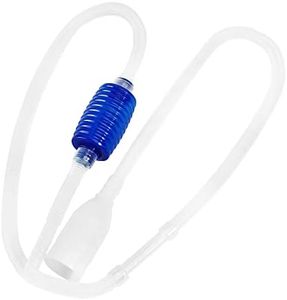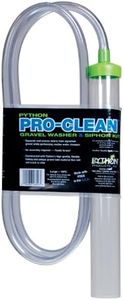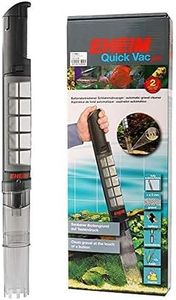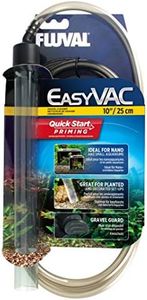We Use CookiesWe use cookies to enhance the security, performance,
functionality and for analytical and promotional activities. By continuing to browse this site you
are agreeing to our privacy policy
10 Best Aquarium Vacuum
From leading brands and best sellers available on the web.Buying Guide for the Best Aquarium Vacuum
Choosing the right aquarium vacuum is important for keeping your tank clean and your fish healthy. There are many types of vacuums available, each designed for different tank sizes, substrates, and cleaning needs. Before you buy, think about the kind of tank you have, how often you want to clean it, and how easy you want the cleaning process to be. Understanding the key features of aquarium vacuums will help you make a choice that makes cleaning easier and more effective for your specific setup.Type (Manual vs. Electric)The type of aquarium vacuum refers to whether it is powered by hand (manual) or relies on a motor or electric pump (electric/battery). Manual vacuums usually work by squeezing a bulb or using gravity to create suction. These are often simple, reliable, and best for smaller tanks or quick cleanups. Electric or battery-powered vacuums make cleaning faster and require less effort, especially useful for larger tanks or for people who want convenience. To decide, consider the size of your tank and how much effort you want to put in: for a small tank or if you prefer more control, a manual vacuum is enough; for bigger tanks or frequent cleans, electric models might suit you better.
Suction PowerSuction power affects how efficiently the vacuum removes dirt and debris from the tank. Low suction is gentler on the substrate and best for light debris or delicate setups, while higher suction can remove more stubborn waste but might disturb sand or gravel. Look for vacuums with adjustable suction if your setup varies. If you have a sensitive or planted aquarium, go for gentler suction. For tanks with lots of fish or messier conditions, stronger suction helps with faster, deeper cleaning.
Hose/Tube LengthThe length of the hose or tube determines how easily you can reach all parts of your tank and how far your bucket or drain can be from the aquarium. Shorter hoses are fine for small tanks or cleaning close to the tank, while longer hoses help with large tanks or if your waste water needs to go further away. Measure your tank height and the distance to wherever you’ll drain the water, and choose a hose length that allows comfortable, spill-free cleaning.
Gravel Cleaning FeatureSome vacuums come with a gravel cleaning attachment, which stirs up gravel or substrate to loosen trapped waste and make it easier to remove. This is important if your tank has gravel, as waste often settles between the pieces. Vacuums designed for gravel have wide heads or special attachments. Choose a vacuum with this feature if you use gravel or stones, but it’s less important for bare-bottom or sand tanks.
Debris Collection SystemThis describes how the vacuum separates and collects solid debris from the water. Some vacuums have built-in filters or mesh bags to trap particles while returning water to the tank, while others simply remove dirty water. If you want to clean without large water changes, choose a vacuum with debris collection—a good choice for spot cleaning. If you combine vacuuming with water changes, a simpler model is fine.
Ease of Use and MaintenanceEase of use covers how simple the vacuum is to assemble, operate, and clean afterward. Look for models with quick-start features, ergonomic handles, and parts that come apart easily for rinsing. Low-maintenance vacuums are helpful if you clean often or value convenience. Consider your comfort with handling aquarium equipment; if you’d rather spend less time fiddling with tools, go for user-friendly designs.
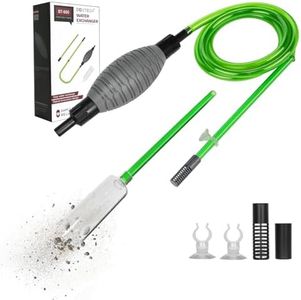

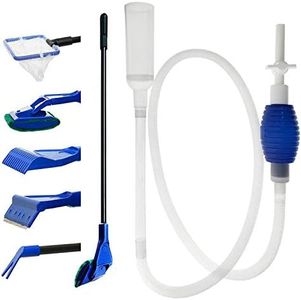
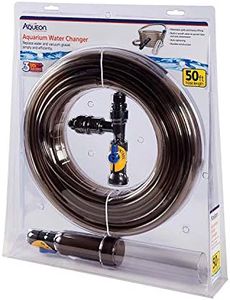
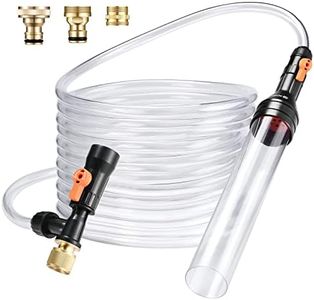
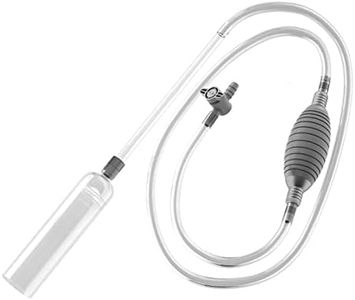
![QZQ Aquarium Gravel Cleaner [2023 Edition] Vacuum Fish Tank Vacuum Cleaner Tools for Aquarium Water Changer with Aquarium Thermometers Fish Net kit Use for Fish Tank Cleaning Gravel and Sand](https://images-proxy.bestreviews.guide/iDz7gelLco-KRG4mbJmSJzBQfnM=/0x300/https://m.media-amazon.com/images/I/51S+2N20RtL._AC_CX679_.jpg)
